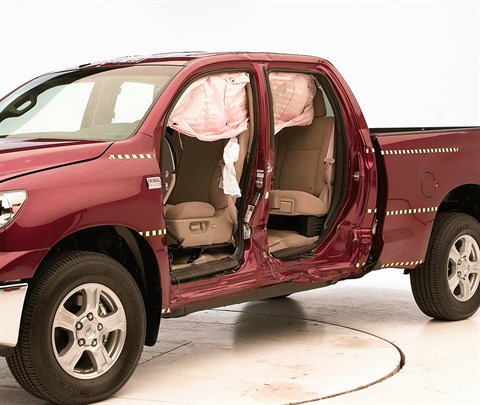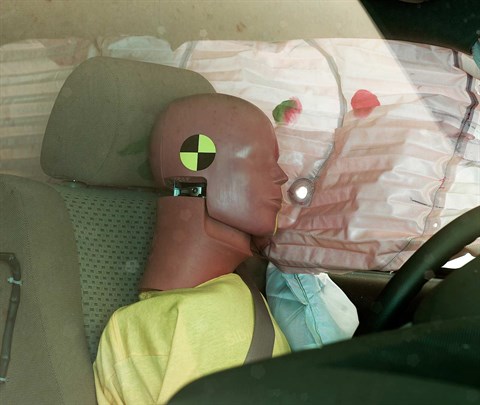Moderate overlap front: original test
Rating applies to 2010-13 models
Tested vehicle: 2010 Toyota Tundra SR5 Double Cab 2wd
The Toyota Tundra Double Cab was redesigned for the 2007 model year. Beginning with 2010 models, the driver and passenger frontal airbags and front seat belts were modified and knee airbags for the driver and front passenger were added. Moderate overlap frontal ratings are assigned by the Institute based on a test conducted by Toyota. Because there were no structural changes, the structure rating of the current model is based on both Toyota's test and two earlier tests of a 2007 Tundra model.
| Evaluation criteria | Rating |
|---|---|
| Overall evaluation | |
| Structure and safety cage | |
| Driver injury measures | |
| Head/neck | |
| Chest | |
| Leg/foot, left | |
| Leg/foot, right | |
| Driver restraints and dummy kinematics | |
Side: original test
Rating applies to 2007-13 models
Tested vehicle: 2007 Toyota Tundra SR5 Double Cab 2wd with standard front and rear head curtain airbags and standard front seat-mounted torso airbags
The Toyota Tundra Double Cab was redesigned for the 2007 model year.
| Evaluation criteria | Rating |
|---|---|
| Overall evaluation | |
| Structure and safety cage | |
| Driver injury measures | |
| Head/neck | |
| Torso | |
| Pelvis/leg | |
| Driver head protection | |
| Rear passenger injury measures | |
| Head/neck | |
| Torso | |
| Pelvis/leg | |
| Rear passenger head protection | |

View of the vehicle and barrier just after the crash test.

View of the vehicle after the crash with doors removed, showing the side airbags and damage to the occupant compartment.

Smeared greasepaint shows where the driver dummy's head was protected from being hit by hard structures by the side curtain airbag.

Smeared greasepaint shows where the rear passenger dummy’s head was protected by the side airbag.
Roof strength
Rating applies to 2007-21 models
Tested vehicle: 2011 Toyota Tundra Double Cab 2wd
| Overall evaluation | |
|---|---|
| Curb weight | 5,142 lbs |
| Peak force | 23,069 lbs |
| Strength-to-weight ratio | 4.49 |
Head restraints & seats
Seat type: Manual cloth seats
| Overall evaluation | |
|---|---|
| Dynamic rating | |
| Seat/head restraint geometry |
About the head restraint & seat test
Currently, IIHS tests apply only to front seats.
